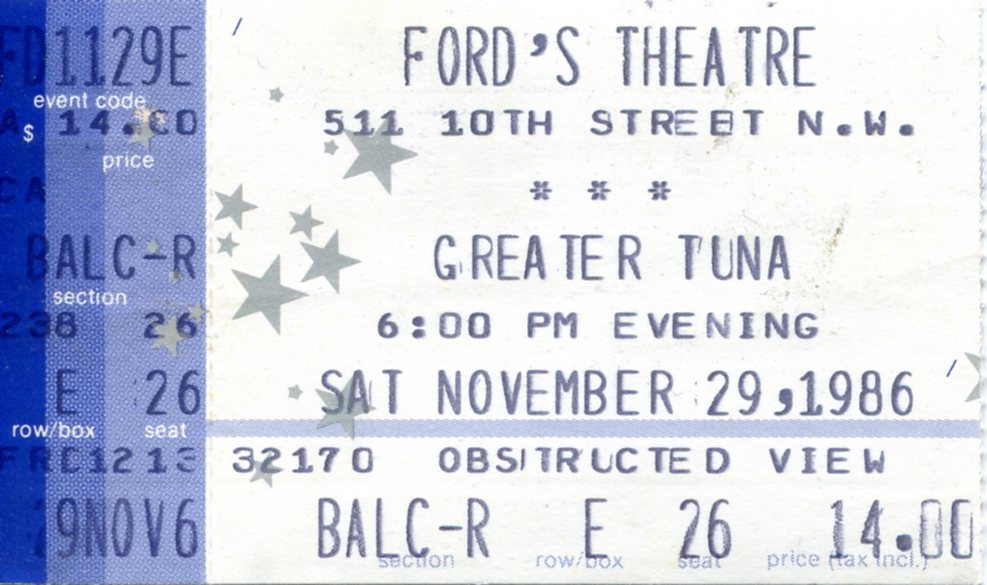Will Reagan-era Washington DC ever evoke the kind of nostalgia New York of various decades does, or London of the ’60s, or the once-removed nostalgia for Paris or Berlin of the ’20s? The Americans doesn’t really trade on nostalgia for the time, even though it’s set then. Who knows?
All I know is that I visited DC a number of times during the mid-1980s. During a late ’86 visit, I went to Ford’s Theatre for a performance of Greater Tuna.
 I don’t remember a lot about Greater Tuna, except that it was a somewhat dark, two-man farce about a fictional small town in Texas. According to Samuel French, which licenses the play, Greater Tuna was originally produced in 1981 in Austin by its authors, Jaston Williams, Joe Sears and Ed Howard. The play’s stars, Williams and Sears, played all 20 characters, and Howard directed.
I don’t remember a lot about Greater Tuna, except that it was a somewhat dark, two-man farce about a fictional small town in Texas. According to Samuel French, which licenses the play, Greater Tuna was originally produced in 1981 in Austin by its authors, Jaston Williams, Joe Sears and Ed Howard. The play’s stars, Williams and Sears, played all 20 characters, and Howard directed.
Greater Tuna was first presented Off Broadway at Circle in the Square in New York City on October 21, 1982. It ran for over a year Off Broadway, and “went on to tour major theatres all over America and spots overseas for the next 30 some years, and became one of the most produced plays in American theatre history,” notes Samuel French.
I think Joe Sears and Jaston Williams were still the two men doing all the parts in 1986, but I wouldn’t swear to it. All I have left is a ticket stub and a recollection of it being entertaining.
Ford’s Theatre, of course, has a doleful history of its own. The president’s box is still draped with flags, though it’s actually a 1960s reconstruction of the original, as is the entire theater space, with more changes made in a 2008 renovation. During the most recent renovation, the Washington Post ran an article containing a brief history of the place:
“Ford’s Theatre was a Baptist church until it was taken over in 1861 by entrepreneur John T. Ford. The venue was destroyed by fire the night of Dec. 30, 1862, but was rebuilt and reopened in 1863.
“After the assassination… when Ford sought to reopen for business, there was a public outcry. The government bought the theater from Ford and used it over the years as a museum and as an office and storage building.
“On the morning of June 9, 1893, the building was packed with 500 government clerks, occupying several floors of jury-rigged office space, when the interior collapsed, according to a Washington Post account the next day. Scores were killed and injured, and the theater’s already altered interior was destroyed.
The government rebuilt it again — and again used the building for storage. In the 1950s, the government decided to restore the building as a historic site and theater venue, and Ford’s reopened in 1968.”
It just occurred to me that I’ve visited three of the four sites of presidential assassinations: Ford’s Theatre, the National Gallery of Art’s West Building (built on the site of Baltimore & Potomac Railroad station where President Garfield was shot, though unmarked), and the Texas School Book Depository building. Guess that means I need to visit Buffalo.